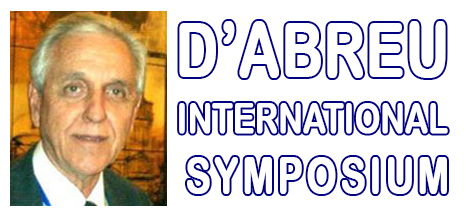List of Accepted Abstracts As of 13/12/2025: (Alphabetical Order)
Summit Plenaries
D'Abreu International Symposium (4th Intl. Symp. on Advanced Sustainable Iron and Steel Making)
Dubois International Symposium (Intl Sympo. on Sustainable Complex Metallic Systems)
Űye International Symposium (Intl Symp. on Sustainable Ionic Liquid and Aluminum Extraction and Processing)
Santilli International Symposium (Intl. Sympo. on Sustainable Mathematics Applications)
Starkey International Symposium (3rd Intl. Symp. on Sustainable Mineral Processing: Principles, Technologies and Industrial Practice)
Yagi International Symposium (2nd Intl. Symp. on Sustainable Metals & Alloys Processing)
Yang International Symposium (3rd Intl. symp. on Multiscale Material Mechanics and Multiphysics and Sustainable Applications)
2nd Intl. Symp. on Advanced Materials and Technologies for
Sustainable Energy and the Environment(AMTSEE)
2nd Intl. Symp. on Multifunctional and Smart Materials, Systems and Structures for Sustainability (MSMSSS)
3rd Intl. Symp. on Sustainable Secondary Battery Manufacturing and Recycling
3rd Intl. Symp. on Sustainable Base-metal Bio-extraction
3rd Intl. Symp. on Sustainable Cement Production
Intl. Symp. World Forum on Sustainable Coal Combustion and Processing
3rd Intl. Symp. on Sustainable Surface and Interface Engineering: Coatings for Extreme Environments
4th Intl. Symp. on Composite, Ceramic and Nano Materials Processing, Characterization and Applications
3rd Intl. Symp. on Sustainable Energy Production: Gas/Oil/Shale; Coal; Nuclear; Waste/Bioprocessing and renewables: wind/waves
5th Intl. Symp. on Environmental, Health, Policy, Legal, Management and Social Issues Related to Metals, Materials and Mineral Processing
3rd Intl. Symp. on Sustainable Production of Ferro-alloys
3rd Intl. Symp. on Sustainable Mining Operations
4th Intl. Symp. on Sustainable Molten Salt and Ionic Liquid Processing
3rd Intl. Symp. on Synthesis and Properties of Nanomaterials for Future Energy Demands
4th Intl. Symp. on Sustainable Non-ferrous Smelting and Hydro/Electrochemical Processing
2nd Intl. Symp. on Physics of Surfaces and Interfaces, from Fundamentals to
Sustainable Applications
4th Intl. Symp. on Quasi-crystals, Metallic Alloys, Composites, Ceramics and Nano Materials
3rd Intl. Symp. on Rare Earth and Platinum Group Metals: Managing and Processing
4th Intl. Symp. on Sustainable Materials Recycling Processes and Products
Intl. Symp. on Rotary Kiln Operations for Sustainable Products
3RD INTL. SYMP. ON SUSTAINABLE MINING OPERATIONS
Analysis the NOX Emission Reduction Cost of Cement Production in China by using the Marginal Cost Function
X.
Li1 ;
1, Beijing, China;
Type of Paper: Regular
Id Paper: 78
Topic: 4The National Total Emission Control (NTEC) Program continued to be implemented during the 12th Five-Year Plan period (FYP, 2011-2015) in China. Two major air pollutants (SO2 and NOX) are covered by the NTEC, of which NOX is a newly included pollutant under control. NTEC requires the total national NOX emission level reduce by 10% by 2015, based on that of 2010. Besides of coal-fired power plants and motor vehicles, cement production is the major source of NOX emission in China, it is necessary for the Chinese government to make economic policies, including to design and to implement a subsidy for denitrification to reduce NOX emission. This article details in NOX pollution situation in China, especially in the cement industry, and the meanings of denitrification subsidy for cement production. Marginal costs of NOX emission reduction in cement industry were calculated, based on survey data of investment and O&M costs of denitrification equipment in cement plants across China. The result shows that the marginal cost of NOX reduction in the cement plant is over 4 CNY/kg. Policy suggestions including setting up subsidy are given for the denitrification. Keywords: NOX emission reduction, subsidy, marginal cost, cement production, industry
Combination Of Minerals Transportation With Their Enrichment In Underground Conditions As A Way Of Solving Environmental Problems Of Mining
A.
Brodt1 ;
1S.G.B.D. TECHNOLOGIES LTD, Tel Aviv, Israel;
Type of Paper: Regular
Id Paper: 193
Topic: 4Modern mining of minerals is becoming an increasingly complicated technological and ecological problem. It can be explained both by worsening of geological conditions of mining and by a specific character of the mining industry, which, in contrast to processing branches of industry, intrudes into one of the principal components of nature, the Earth's interior.
The only possibility is the use of the Archimedes law for delivery minerals from a mine to the surface by its floating in a motionless medium of a higher density. Besides, the choice of a liquid medium with density intermediate between those of the mineral (e.g., coal) and the waste rock for the realization of such transport process provides a real possibility of combining the delivery of produced coal from a mine to the ground surface with its simultaneous beneficiation.
The product is left to float in a liquid medium, followed to the place destination by rafting.
After complete regeneration, the fluid is returned to the head of the process.
In-line Analyses of Geology and Process Parameters for Mine and Processing Plant Integration
E.
Hill1 ;B.
Tordoff1 ;
1ZEISS, Cambridge, United Kingdom (Great Britain);
Type of Paper: Regular
Id Paper: 418
Topic: 4The relatively low price of commodities has generated economic headwinds for the mining industry. Rather than adopting a bury the head in the sand approach, the market resistance is driving improvements in ore modelling, in the development and implementation of processes, and in the monitoring of the ore and of the recovery processes. An awakening to the fact that the data necessary to make informed geometallurgical decisions, on a daily basis, is critical to every operation is under way. Modern developments in the analysis of ore and of process mineralogy, aided by the ability to monitor changes in ore composition and in the products of the processing plant, are driving real-time improvements in mine processing and profitability. The ability to perform mineralogical analyses, on-site, improves the knowledge of the ore and permits rapid adjustment of processing parameters to deal with variations in the ore feed.
Using examples from active, on-the-mine, ruggedized-automated-mineralogy systems performing routine and detailed analyses, we will describe how an innovative approach has helped integrate the recognition of variable mine geology with the adaptability of the recovery process. We will also describe how the application of engineering and technological advances permit remote investigation and assessment in a manner such that unforeseen circumstances can be tackled in a matter of hours - no longer in a matter of days or weeks. Keywords: Copper; Efficiency; Gold; Iron; Lead; Mining; Ore; Plant; Platinum; Processing; Recovery; Silver; Tailings;
Influences of Additions of the Slag from Base Metals Smelting on Strengths of Cemented Paste Backfill of Mill Tailings
Q.
Yang1 ;Q.
Jia2 ;L.
Guo3 ;S.
Knutsson4 ;P.
Xue5 ;G.
Liu6 ;L.
Jiang6 ;
1DIVISION OF MINERALS AND METALLURGICAL ENGINEERING (MIMER), Lulea, Sweden; 2LULEć UNIVERSITY OF TECHNOLOGY, LULEĆ, Sweden; 3BEIJING GENERAL RESEARCH INSTITUTE OF MINING & METALLURGY, Beijing, China; 4LULEć UNIVERSITY OF TECHNOLOGY, Luleć, Sweden; 5UNIVERSITY OF SCIENCE AND TECHNOLOGY BEIJING, Beijing, China; 6BEIFANG UNIVERSITY OF NATIONALITIES, Yinchuan, China;
Type of Paper: Regular
Id Paper: 161
Topic: 4Via operations of mine backfilling, such as the cemented paste backfill (CPB), the underground voids resulted from mining are filled with waste materials, mainly mill tailings, to provide ground support allowing for a safer working environment and higher ore recovery. The Boliden group uses 96% mill tailings and 4% binder as materials for its CPB operations in Sweden. The operations of concentrates smelting at Ronnskar Smelter of the group generate a slag, which is water-granulated to produce a glassy slag product with an output of 250000 ton/year. The product with particles of sizes<6 mm contains more than 80% of Fe and Si oxides and is named as Fe sand, which has been used for road constructions for many years. Influences of additions of the Fe sand on CPB strengths was investigated in the present study. Different parts of iron sand were mixed together with the tailings sand to make cylinders of the CPB samples. Uniaxial compression tests were performed for the samples after 28 days of curing. The porosities of the samplers after curing were determined. Results from uniaxial compression tests showed that the amount of iron sand added influences positively the UCS developments, as well as content values of fines and porosity. By using the present results, utilizations of a part of Fe-sand together with the tailings sand to increase UCS values for the CPB samples are possible, which will be beneficial for both environmental protection and resource conservation. Keywords: Metal; Mining; Sustainability; Tailings; Underground;
Stability of Slopes of the Surface Coal Mines Using Different Methods
I.
Huseini1 ;
1USHT, Tetovo, Macedonia (Former Yugoslav Republic of Macedonia);
Type of Paper: Regular
Id Paper: 263
Topic: 4The subject of this paper is the analysis of the geo-mechanical stability of slopes of the surface coal mines of the main geometry factors. Its main purpose is to define the interaction between the geological environment and the engineering activity.Therefore, in solving this problem all available documents from the previous researches and examinations for obtaining more credible and relevant data are used. Because of the above mentioned, the thesis shall obtain the following analyses: Description of the existing situation from geological aspect; Application of various numeric and graphical methods; Selection of most optimal geometric parameters and stability analysis; In general, various methods are used for slope stability analysis. They can roughly be divided into two groups, such as Border balance methods. In general, the slope stability analysis consists of the following components: Safety Factor Fs; Slope Geometrical properties; Physical-mechanical properties of tested soil materials; Ground water. The stability calculation shall be conducted by various methods with the software packages GGU Stability (BISHOP, JANBU). Discovering the right measure and the exact ratio between the advantage and the limitations of a given method is possible only through appropriate methodological approach, where aspects relevant to specific problems in geotechnical engineering shall be analyzed. Following significant results occurred from the work on this doctoral dissertation: 1) Analysis and sensitivity evaluation of the safety factor in the change of the values of certain geo-mechanical parameters. 2) A critical review of the selection of methods for geo-mechanical stability analysis. Keywords: Dust; Energy; Engineering; Exploration; Grind; Industry; Mining; Processing; Technology;
« Back To Technical Program
|



